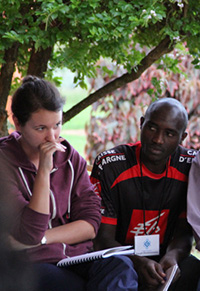Reconnecting with Compassion
By Teri SivilliIn a widely shared article in The Guardian on April 29, 2015, Secret Aid Worker (S.A.W.) wrote of fears that the work “is affecting the aspect of my personality that made me want to become an aid worker in the first place: my compassion.”
While not downplaying the personal benefits of a satisfying career, the anonymous writer nevertheless voiced a fear that is all too common in this sector, though rarely discussed openly, in my experience: that we cannot be constantly exposed to the suffering of others and remain unaffected by it.
In more than one hundred comments on the essay, readers – many of them aid workers themselves – discussed their own experiences of working in humanitarian settings, both similar to and different from S.A.W.’s experience.
Few touched on the topic that I think deserves deeper investigation: the interconnected relationships among suffering, empathy and compassion.
First, for transparency, you should know that I manage a training program designed to build resilience among aid workers through the use of contemplative practices such as meditation and yoga. From that perspective, I’d like to offer a framework for understanding S.A.W.’s experiences that may be helpful for him/her, and for others.
S.A.W. talks about being desensitized to pain and suffering, and also notes that “You obviously cannot do your job if you just break down and cry all the time.” Very true. But what we’re learning now is there’s a middle way between those two responses.
Aid workers responding to short- or long-term humanitarian emergencies will experience some degree of stress. How much depends on the situation and their own coping resources.
From the essay, S.A.W. sounds like an empathic and self-reflective person. Emotions such as empathy are part of our make-up as humans; they connect us with others and provide valuable information about the world around us. The ability to recognize nuances in our emotions, and to name them correctly, empowers us to respond to the world appropriately.
As humans, we have the ability to mirror the emotions of others. This can give rise to true empathy, an ability to feel the distress of another person. But it can also lead to emotional contagion, in which we experience the suffering of another – both physiologically and psychologically – as if it were happening to us. This experience can lead us to become overwhelmed by the suffering of others.
I can only speculate here, because I don’t know S.A.W. But I wonder if, after many years of field work, this person has become worn down and overwhelmed, and if his or her natural and important empathy has turned to empathic distress. Distancing ourselves from suffering, as S.A.W. reports doing, is a natural response to empathic distress: overwhelmed by the pain of others, we want (and need) to protect ourselves.
 For that reason, what is often called “compassion fatigue” is more rightly named “empathy fatigue.” Ironically, compassion is the solution, not the problem. Compassion is the wish for others to be free from their suffering, combined with the motivation to do what we can to relieve that suffering. Compassion must be enacted with wisdom, which gives us the discernment to understand and accept our own abilities and limitations in any situation.
For that reason, what is often called “compassion fatigue” is more rightly named “empathy fatigue.” Ironically, compassion is the solution, not the problem. Compassion is the wish for others to be free from their suffering, combined with the motivation to do what we can to relieve that suffering. Compassion must be enacted with wisdom, which gives us the discernment to understand and accept our own abilities and limitations in any situation.
Inherent to compassion is a move towards suffering, rather than away from it. You see, we can’t selectively shut out some emotions and remain open to others. When we shut down and cut off our ability to feel suffering, in an attempt to protect ourselves from feeling too much pain, we also diminish our ability to feel joy and happiness, and rob ourselves of connection to others.
While working in the field decades ago, one of our CBR training graduates had witnessed a horrific massacre. In an attempt to wall off the memory and cope with the trauma, he had become both physically and emotionally rigid. Ultimately, he was unable to continue working in the field and transferred to headquarters.
At the training, within the safe space created by the faculty, touched by the lovingkindness practices, this aid worker was able to release the deep grief he had carried these many years. With the pain came ease, and the first shaky steps towards genuine connection to others, along with greater trust in his abilities to handle the range of his emotional experiences. When we build and enhance our inherent compassion, we open our hearts to all of our experience, all of our shared humanity. It becomes possible for us to transform suffering, rather than be depleted by it.
In the CBR program, we emphasize compassion training for aid workers not just to help them cope with the inherent stress of their work, but also because it can improve their own health, well-being and happiness.
No one benefits when the sector loses an experienced, skilled person like S.A.W. for preventable reasons. The CBR faculty, many of them aid workers themselves, teach how to manage the challenges of aid work in a healthier and more constructive way. Aid workers who work effectively within their organizations and contribute their expertise working alongside those who confront tragedy in this world should not be defeated by burnout, overwhelm and exhaustion. They can learn how to cope with suffering, avoid burnout and thrive in their work.
Teri Sivilli is the program manager for the Garrison Institute’s CBR Project. After observing the persistent effects of the conflicts in Kosovo and Sri Lanka on the mental health of national staff and the affected populations, she became interested in the potential for contemplative-based interventions to heal chronic stress and trauma.
